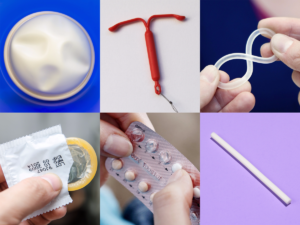
Lactation Guidance for Stress-Free Nursing
Introduction Breastfeeding is a beautiful and natural way to nurture your baby, but it can sometimes come with challenges. At Signora


Birth control, also known as contraception, refers to the methods and devices used to prevent pregnancy. It allows individuals to choose when and if they want to have children. Birth control can be achieved through various means, including hormonal methods (like birth control pills, patches, and injections), barrier methods (such as condoms and diaphragms), intrauterine devices (IUDs), sterilization procedures, and natural methods (like fertility awareness). These methods work in different ways to prevent the fertilization of an egg by sperm or to prevent a fertilized egg from implanting in the uterus.
These methods include birth control pills, patches, vaginal rings, and contraceptive shots. They are effective at preventing pregnancy by altering hormone levels to prevent ovulation and thicken cervical mucus. Pills require daily adherence, while patches and rings are changed monthly, and shots are administered every three months. These methods are generally 91-95% effective with typical use. Side effects can include headaches, weight gain, nausea, and changes in menstrual cycles.
Long-acting options like copper T (intrauterine devices IUDs) and implants are highly effective, with over 99% effectiveness. IUDs are inserted into the uterus and can be hormonal or non-hormonal, lasting 3-10 years. Implants, which are inserted under the skin, release hormones and last up to three years. These methods are ideal for those seeking a low-maintenance, long-term solution without daily or monthly upkeep.
Barrier methods, including condoms, diaphragms, cervical caps, and contraceptive sponges, prevent sperm from reaching the egg. Condoms are unique in that they also protect against sexually transmitted infections (STIs). These methods range in effectiveness from 71-88% with typical use. They are suitable for those who prefer non-hormonal options or need additional STI protection.
Permanent methods such as tubal ligation for women and vasectomy for men are nearly 100% effective. These surgical procedures are designed for those who are certain they do not want future pregnancies. While reversal is possible, it’s not always guaranteed to be successful, making these methods a significant commitment.
Emergency contraception is a backup option used after unprotected sex or contraceptive failure. It’s not intended for regular use but can effectively prevent pregnancy if taken promptly. Options include pills and, in some cases, copper T (IUDs )for immediate post-coital use.
|
Method |
Type |
Effectiveness |
How It Works |
Pros |
Cons |
|
Pill |
Short-acting Hormonal |
91-95% |
Taken daily; prevents ovulation |
Convenient, reversible |
Requires daily use, potential side effects |
|
Patch |
Short-acting Hormonal |
91-95% |
Worn on the skin; releases hormones |
Weekly application, reversible |
Potential skin irritation, hormonal side effects |
|
Ring |
Short-acting Hormonal |
91-95% |
Inserted monthly; releases hormones |
Monthly application, reversible |
Can cause discomfort, hormonal side effects |
|
Shot (Injection) |
Short-acting Hormonal |
94-96% |
Administered every 3 months |
Long-lasting, highly effective |
Requires medical visit, potential weight gain |
|
IUD (Hormonal) |
Long-acting Reversible |
99%+ |
Inserted into the uterus; releases hormones |
Long-term (3-7 years), low maintenance |
Insertion discomfort, possible hormonal side effects |
|
IUD (Copper) |
Long-acting Reversible |
99%+ |
Non-hormonal; prevents sperm from fertilizing the egg |
Long-term (up to 10 years), no hormones |
Insertion discomfort, can cause heavier periods |
|
Implant |
Long-acting Reversible |
99%+ |
Inserted under the skin; releases hormones |
Long-term (up to 3 years), highly effective |
Insertion requires a minor procedure, hormonal side effects |
|
Condoms (Male and Female) |
Barrier |
71-88% |
Physical barrier prevents sperm from reaching the egg |
Protects against STIs, no hormones |
Must use every time, can break or slip |
|
Diaphragm and Cervical Cap |
Barrier |
71-88% |
Inserted before sex; covers cervix to block sperm |
Reusable, non-hormonal |
Must use with spermicide, requires fitting by a doctor |
|
Sponge |
Barrier |
71-88% |
Contains spermicide; inserted before sex |
Over-the-counter, non-hormonal |
Less effective for those who have given birth |
|
Tubal Ligation |
Permanent |
99%+ |
Surgical procedure that blocks or seals fallopian tubes |
Permanent, highly effective |
Surgical risks, not reversible |
|
Vasectomy |
Permanent |
99%+ |
Surgical procedure that cuts the vas deferens |
Permanent, highly effective |
Surgical risks, typically not reversible |
|
Emergency Contraception Pills |
Emergency |
75-89% |
Taken after unprotected sex to prevent pregnancy |
Backup option, available over-the-counter |
Must be taken within 72 hours, not for regular use |
For personalized advice and to find the best birth control method for you, consider visiting Signora Maternity Clinic. Dr. Sushma B.N., a specialist in women’s health, can provide expert guidance tailored to your specific needs and lifestyle preferences, helping you make an informed decision that aligns with your goals.

Introduction Breastfeeding is a beautiful and natural way to nurture your baby, but it can sometimes come with challenges. At Signora

Introduction Prenatal care is one of the most important steps in ensuring a healthy pregnancy. It involves regular check-ups and medical

Introduction Pregnancy is a unique and exciting journey for every woman. However, age can play a significant role in shaping this